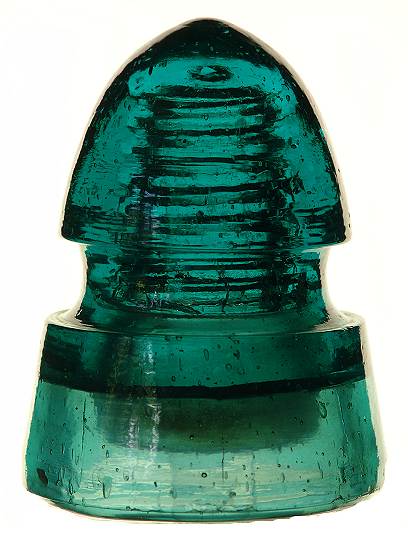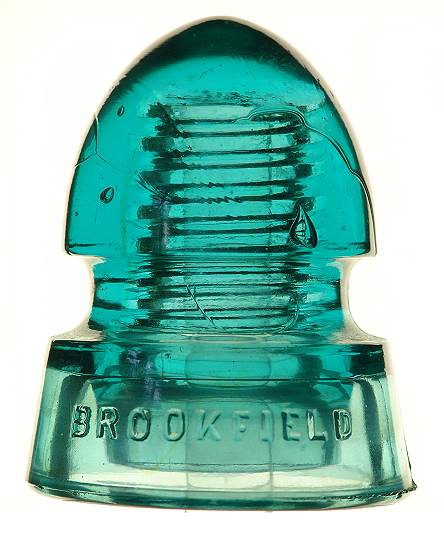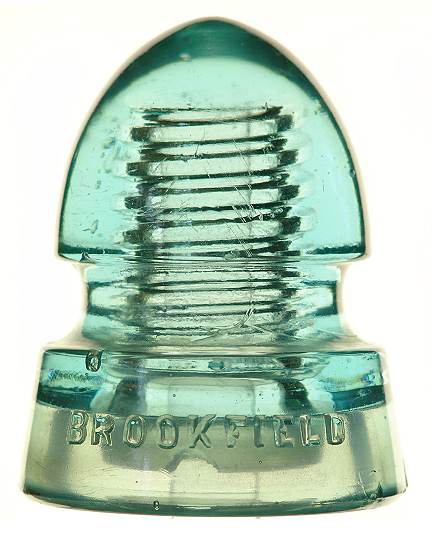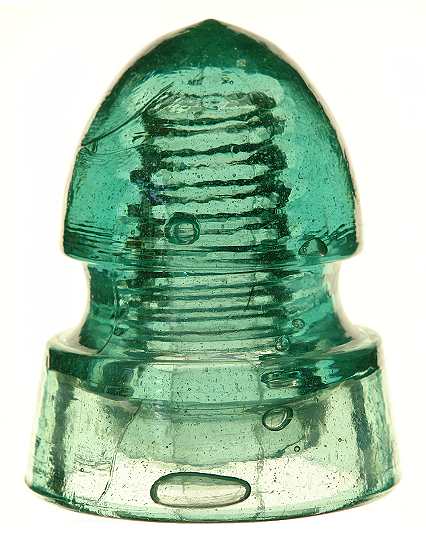BROOKFIELD CD 149
Reprinted from "Crown Jewels of the Wire", August 2005, page 31
In the early seventies near Albany New York, Karen and I had a sales table of
insulators at a Church meeting room. The swap meet was sponsored by the Capital
District Insulator Club. A very distinguish well dressed gentlemen approached
our table and introduced himself as William Brookfield. Said he was trying to
put together a collection of as many Brookfield insulators as he could find that
his family produced.
He was really delighted to find a CD 149 Brookfield on our
table. He told us how difficult of a time he had trying to locate one. That
really made his day and also us talking with him. Now looking back the more that
I think of it I haven't seen very many of these manufactured with the Brookfield
embossing either. Or even in other collectors hands while visiting with them or
on eBay. I think they're a really neat and an unusual looking glass because of the
unusual appearance do to the extra wide wire groove and pointed dome. The
production of this style and quantity must have been very limited and seem tough
to locate.
The Brookfield embossing is located on the front of the skirt of the
insulator with New York on the rear of the skirt. I purchased a small collection
this spring that had a Brookfield in dark aqua, plus 2 pennycuicks in the CD149
style, one of which has a continuous drip. Any information on these Brookfield
"sleepers" would be very much appreciated.
If you have one of these
elusive Brookfield's in your collection let us know what you think. I came
across my first ones on a barn in 1968 in upstate New York which were covered in
white paint. After cleaning off the pair of them I could see one was a light
aqua and the other was a dark green which is the one Mr. Brookfield acquired.
The only other ones that I have are in dark aqua with bubbles running thru it
and a light aqua one. The dark aqua one is from the newly acquired collection
and within a fifty mile radius of where the other two were found on the barn.
This in a thirty seven year span. I think it would be pretty interesting to see
what other readers have and where they came from.
Thanks,
George and Karen
Toften
(518) 827-4606 or toflO@yahoo.com
Editor's note: We've pictured some CD 149's in color on the following two
pages.
CD 149's
THE
WIDE
GROOVE
BEEHIVES
(page 32)
 |
 |
For some collectors the pointed dome is even more
prominent than the extra
wide wire groove,
leading to the nickname "coneheads". |
 |
 |
(page 33)
DESCRIPTIONS OF CD 149's
SHOWN ON PAGES 32 & 33
PAGE 32:
Top: No embossing. (020) style with smooth base. Outstanding amber swirls.
Bottom: Embossed BROOKFIELD on the front and NEW YORK on the reverse.. Also a
character piece due to the heavy amber swirling.
PAGE 33:
Top Left: No embossing. (010) style. This is the unembossed variety with the
"continuous drip". The base is rounded instead of flat. McDougald's
Price Guide describes a continuous drip as a rounded projection that goes all
the way around the base and forms a ledge on the inside and outside of the base.
The color the insulator shown is dark aqua with lots of seed bubbles.
Top Right: Embossed BROOKFIELD on the front and NEW YORK on the reverse. The
color is aqua.
Lower Left: Embossed BROOKFIELD on the front and NEW YORK on the reverse. The
color is light aqua.
Lower Right: No embossing. (020) style with smooth base. This insulator is
listed in the Price Guide in ten different colors. The color of the one shown is
a little odd, and is probably best described as light green aqua.
There are only three major varieties of the CD 149's, and all three are shown
in the color photos. But some examples are found in dramatic colors. Listed in
the Price Guide are:
* Dark green for the Brookfield examples.
* Yellow olive green for the continuous drip example.
* And the other unembossed style is known in teal green, yellow green and
sapphire blue. If any reader owns a CD 149 in one of those brilliant colors,
CJOW would love to have a color photo and would gladly publish it. We'd also be
interested in hearing if anyone has an idea or suggestion for who might have
manufactured the unembossed 149's. Some, but not all examples, have
characteristics similar to Pennycuick style insulators. Pennycuick produced
several insulator styles with a continuous drip, so there may be some
consistency to this theory. Any thoughts? Write or email us here at Crown
Jewels.
| 